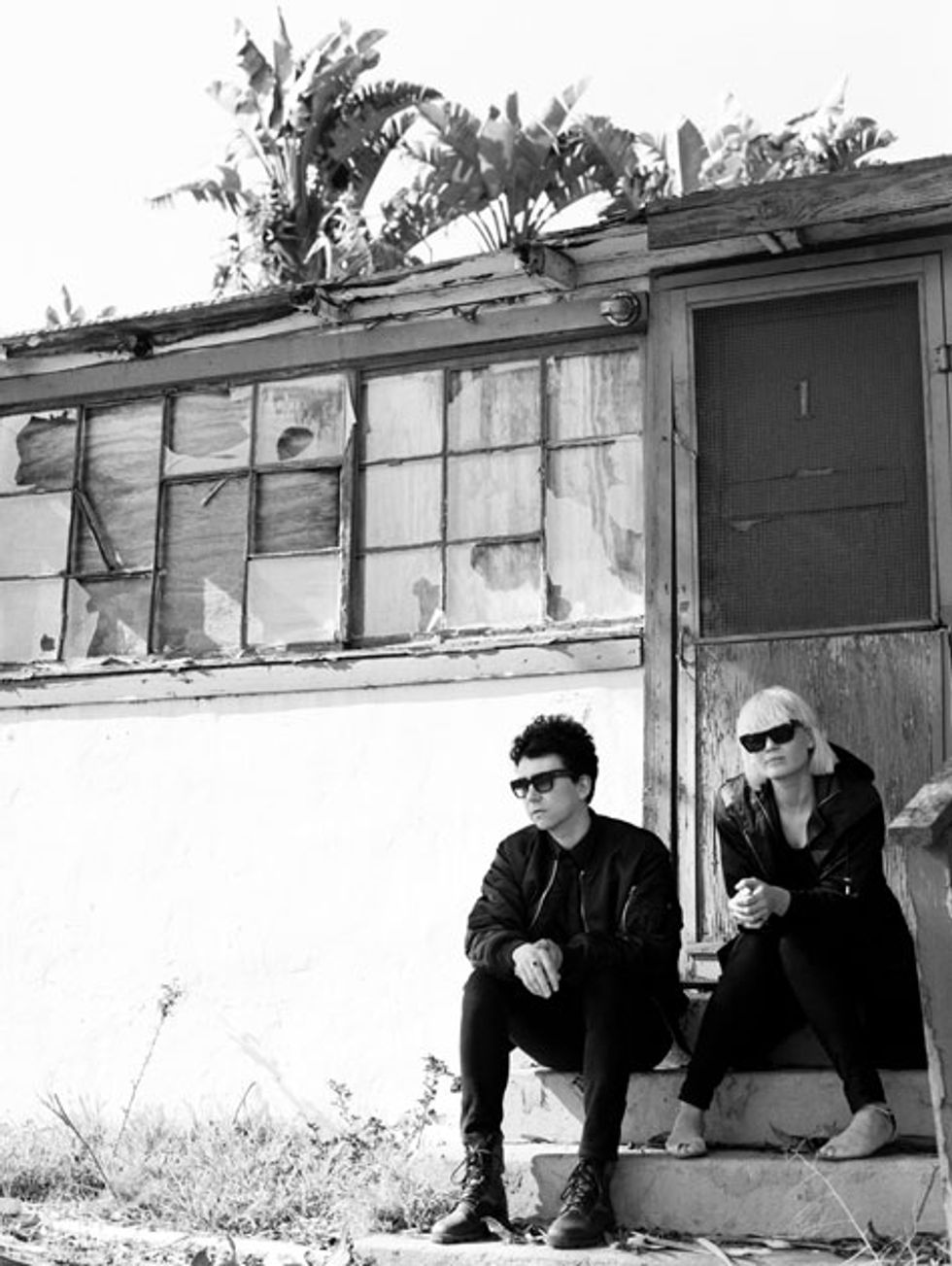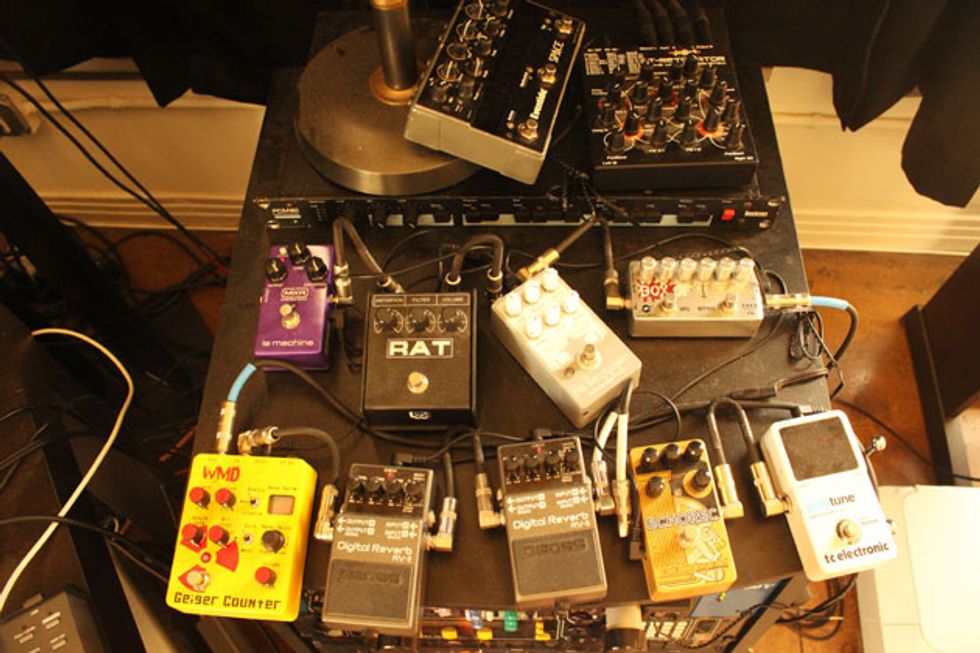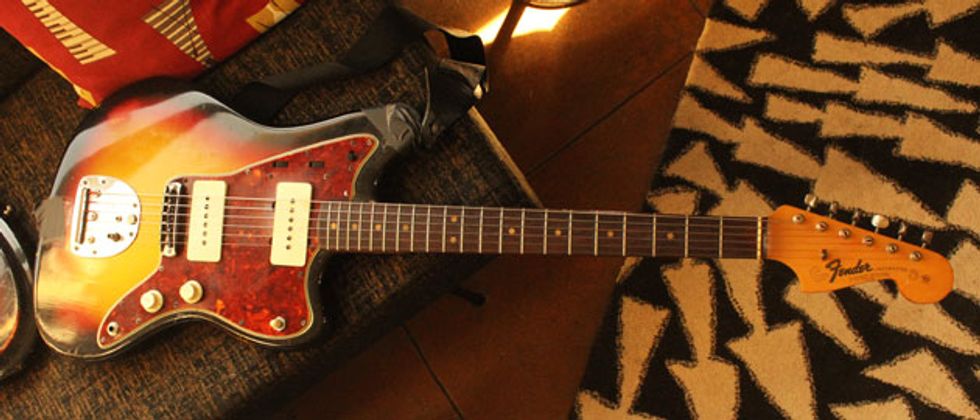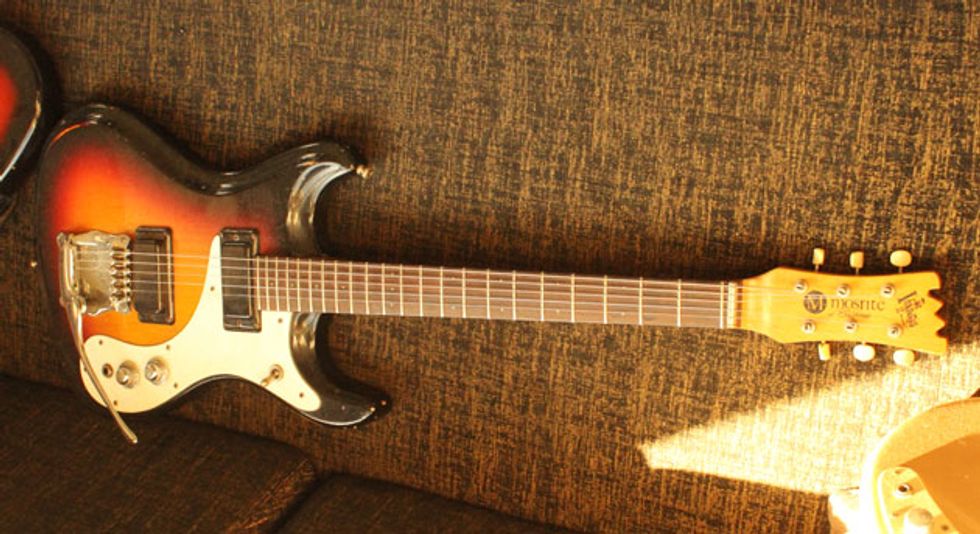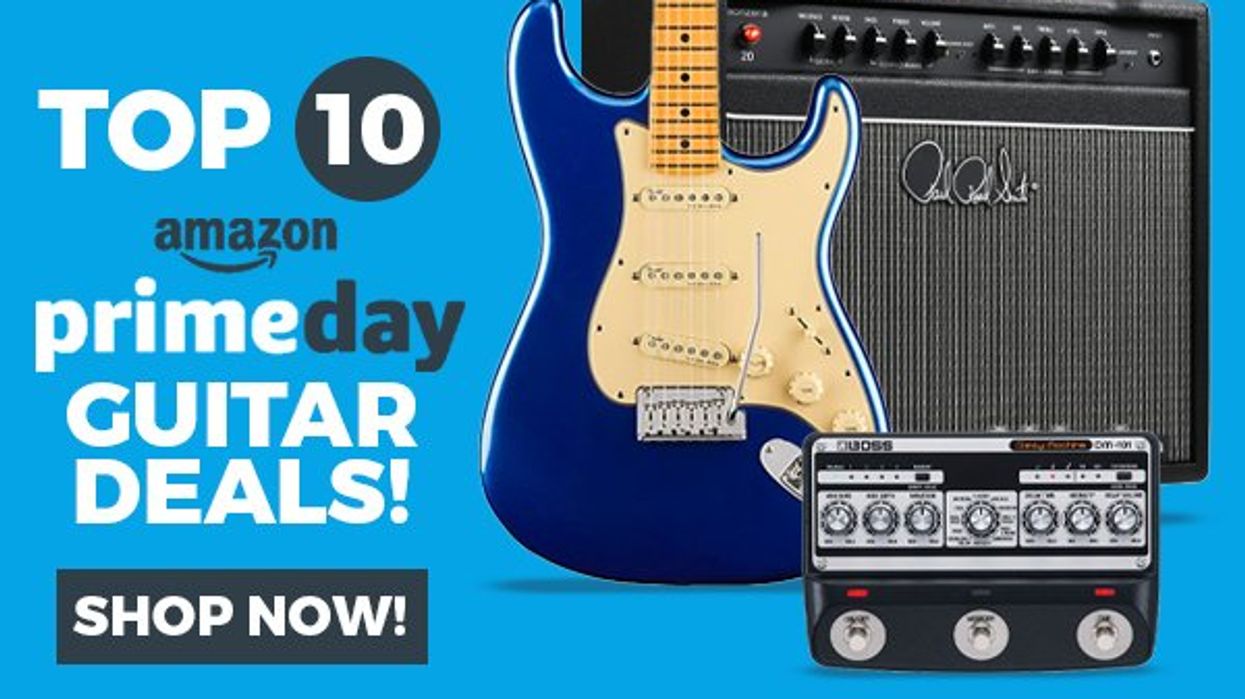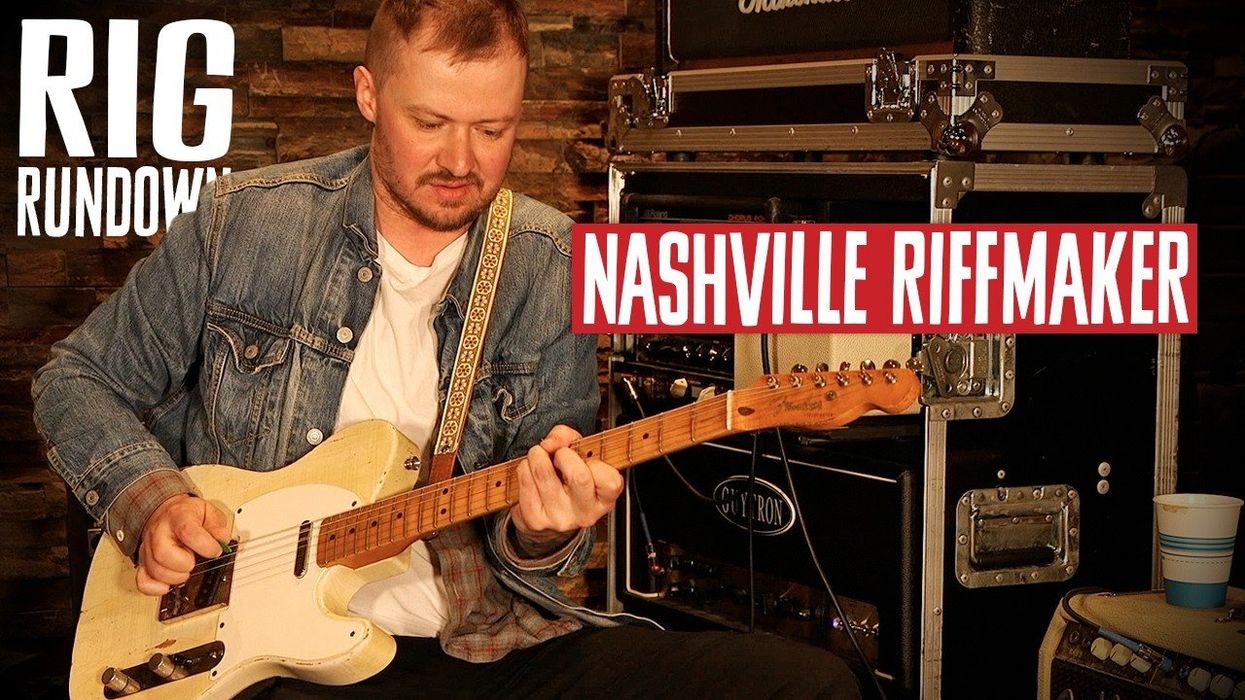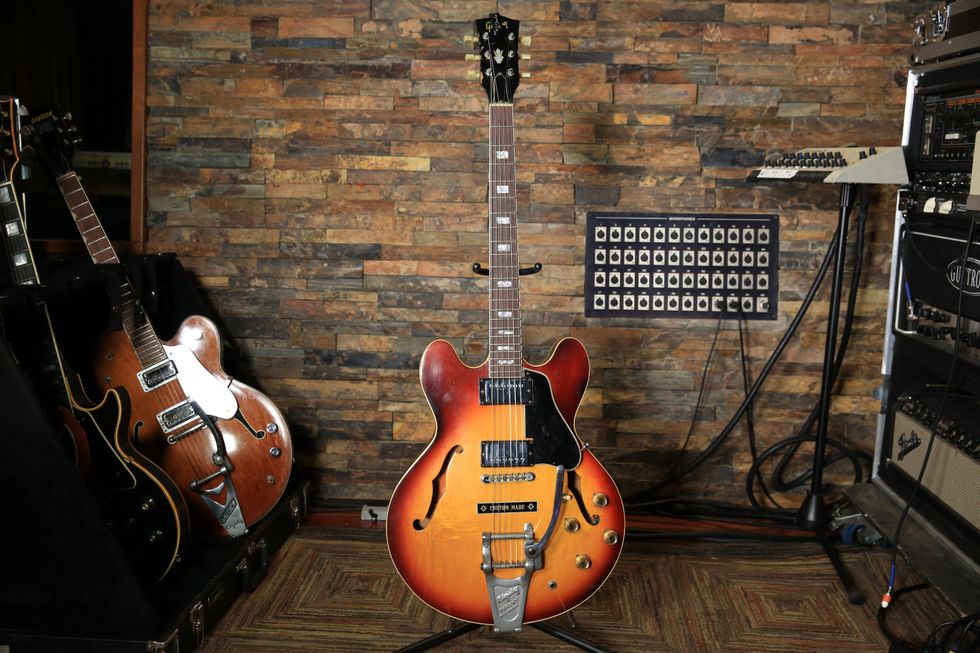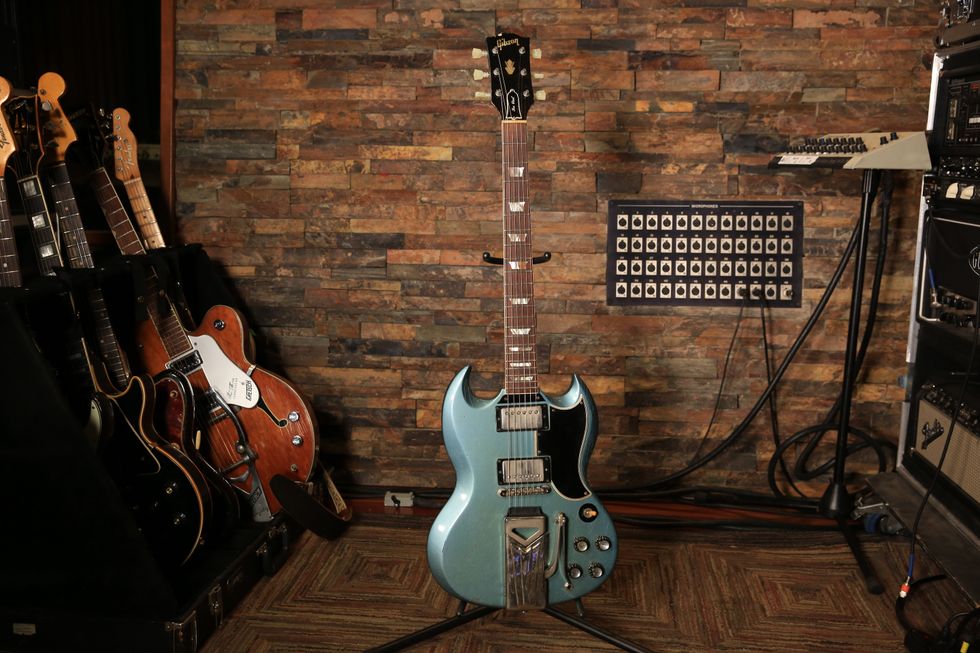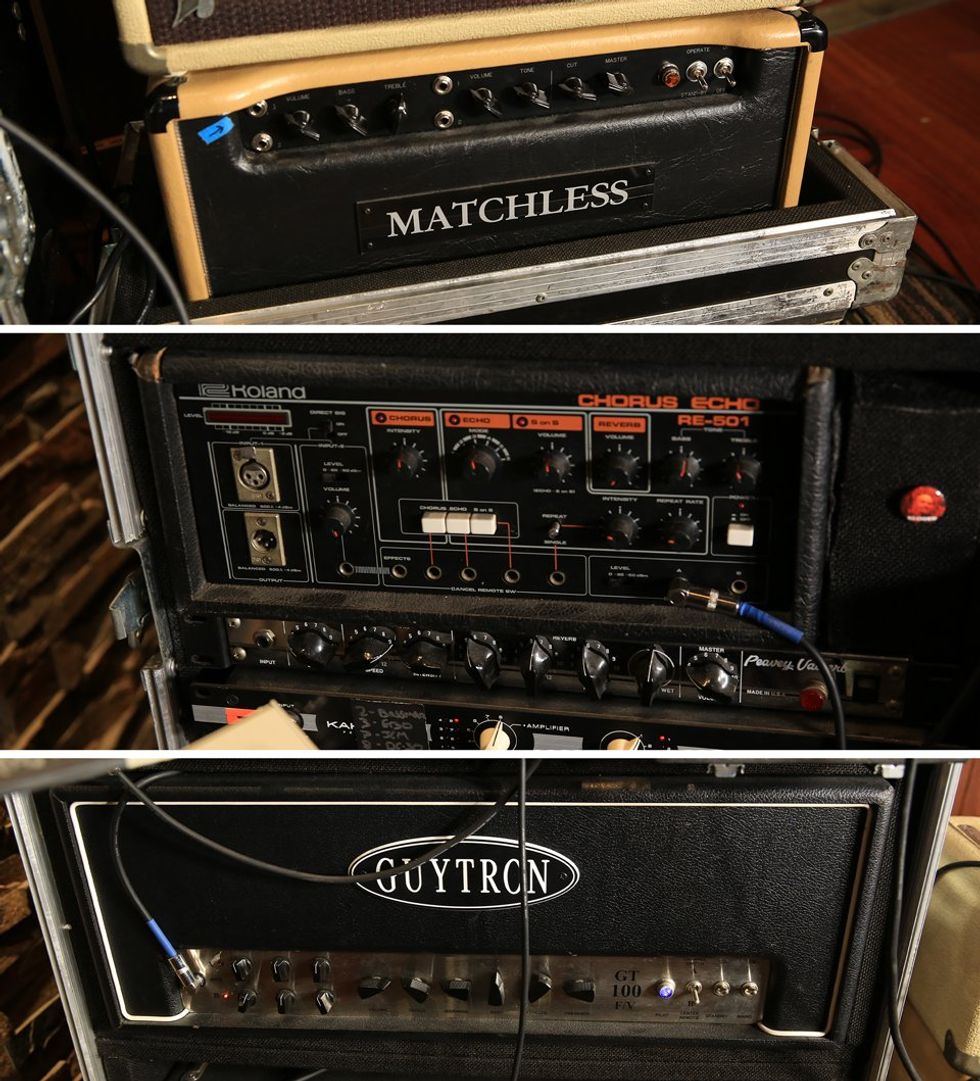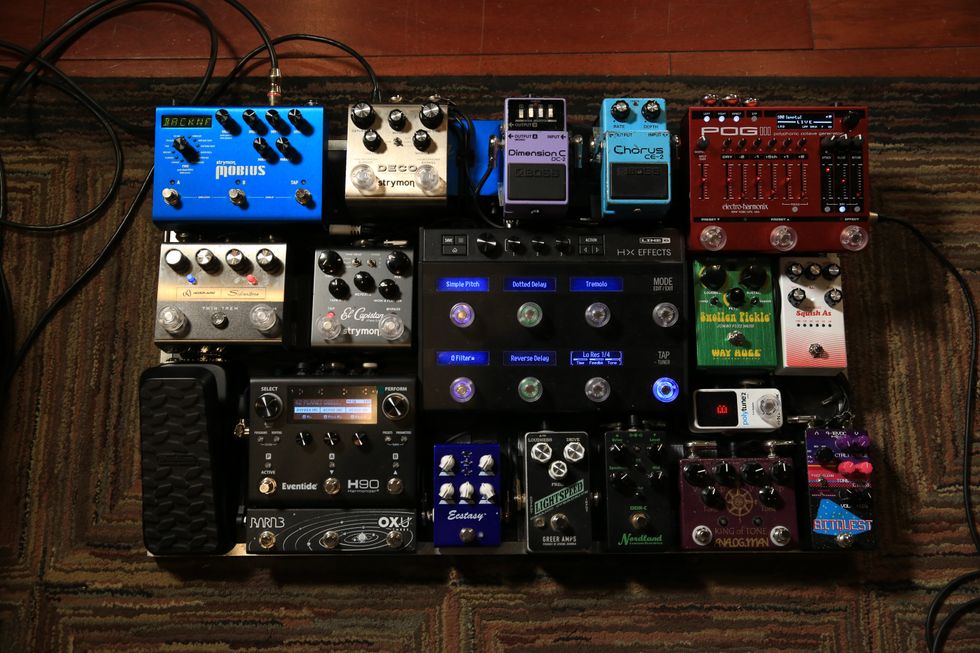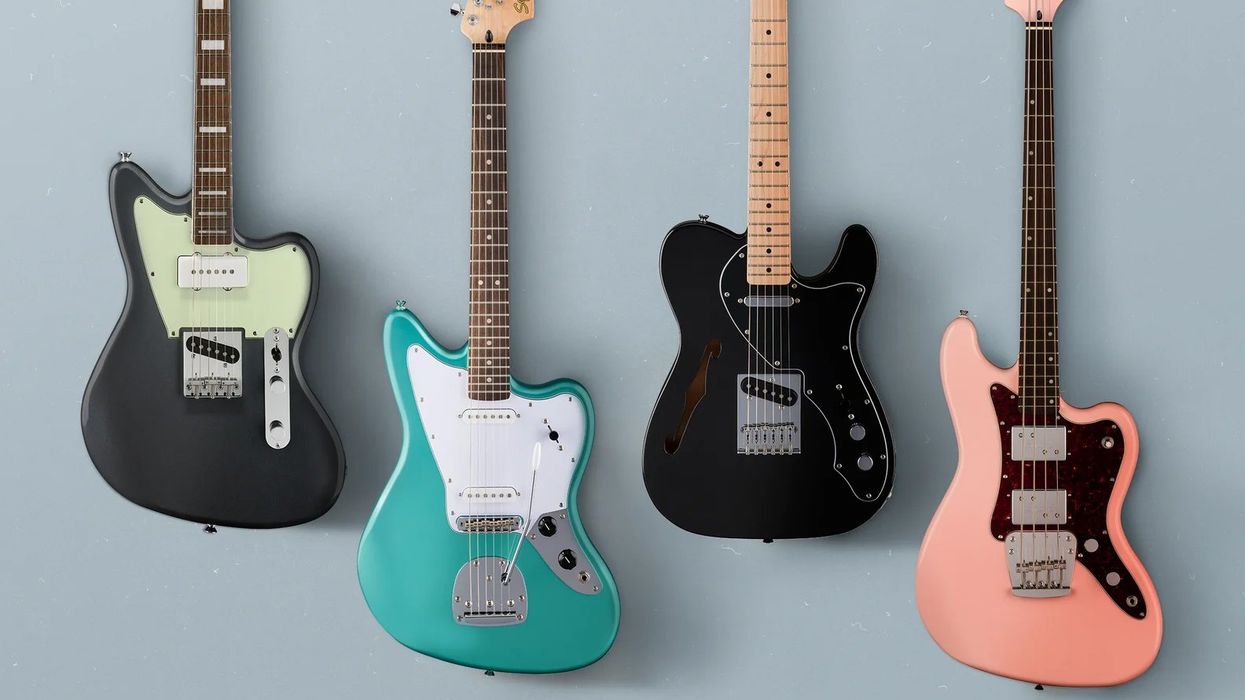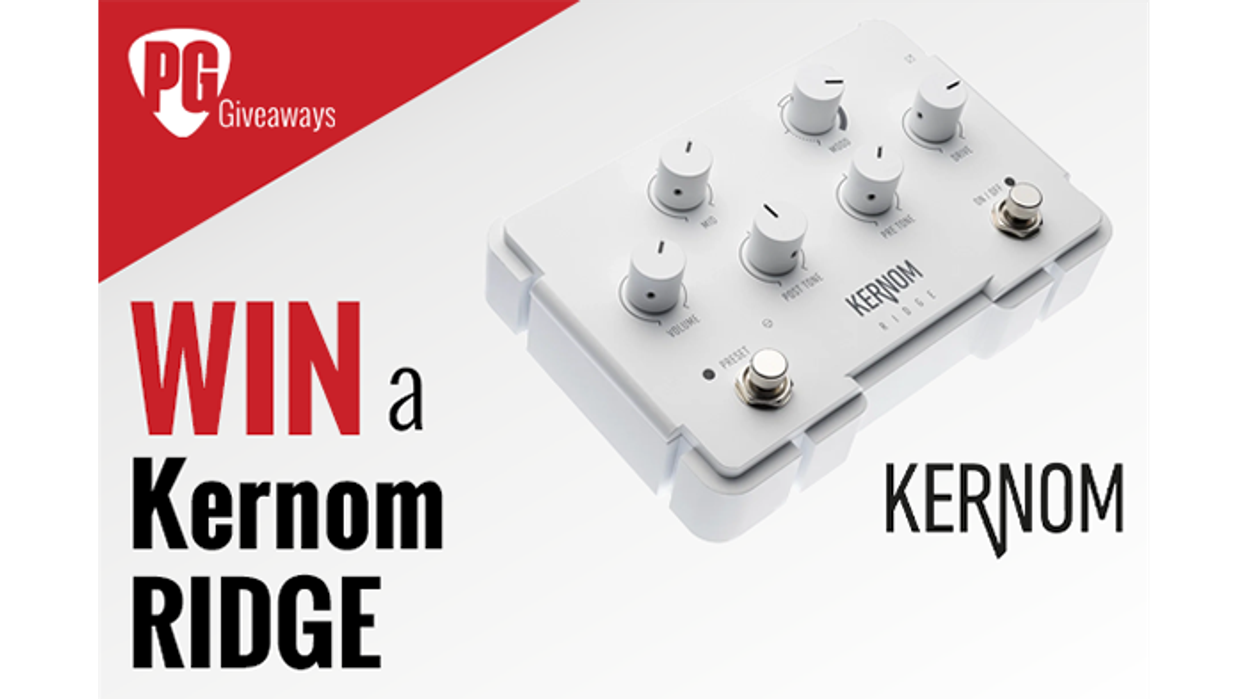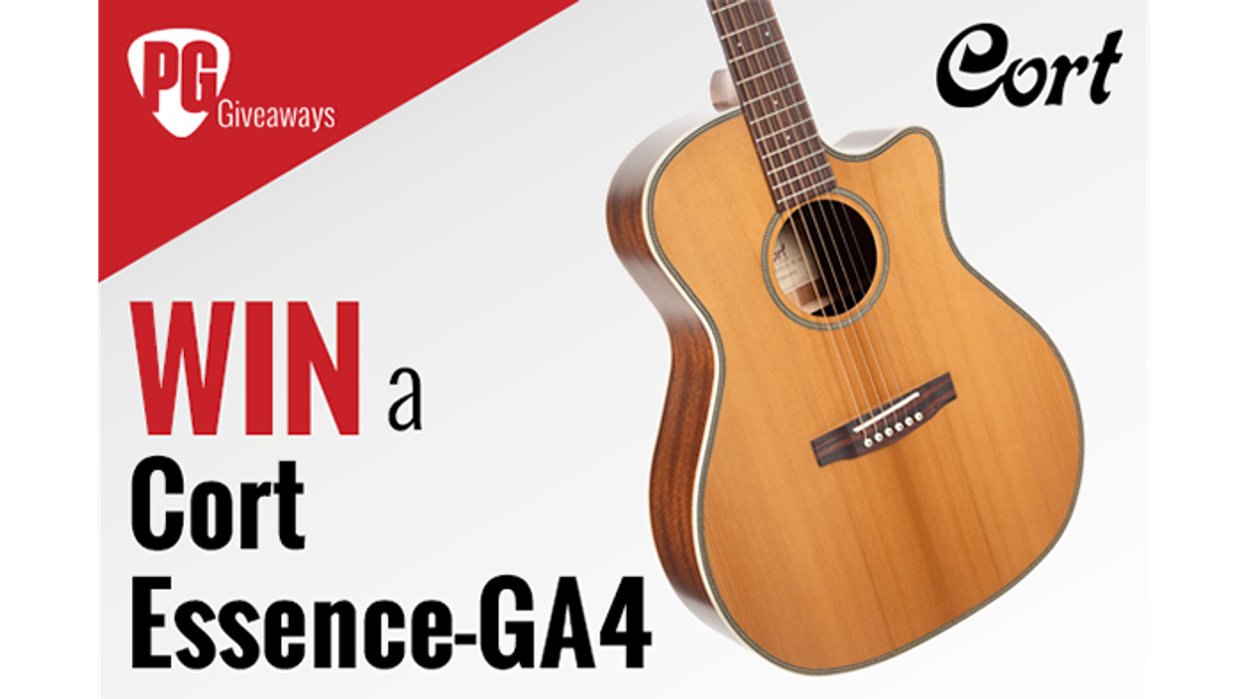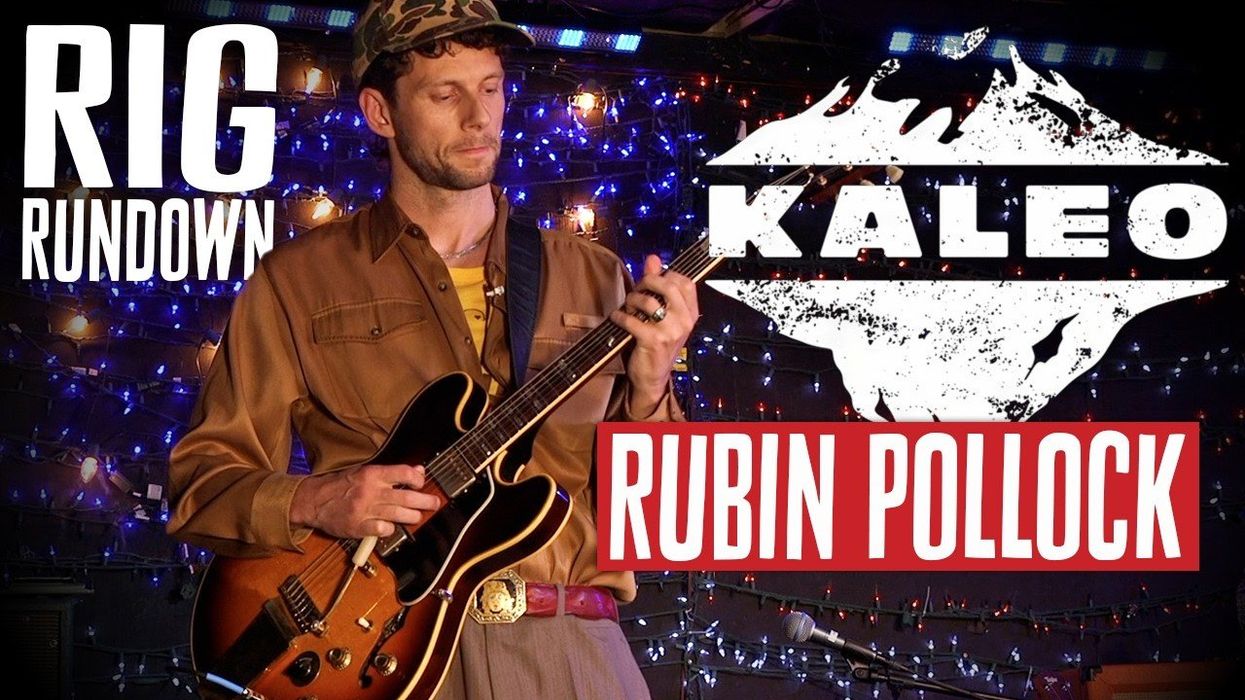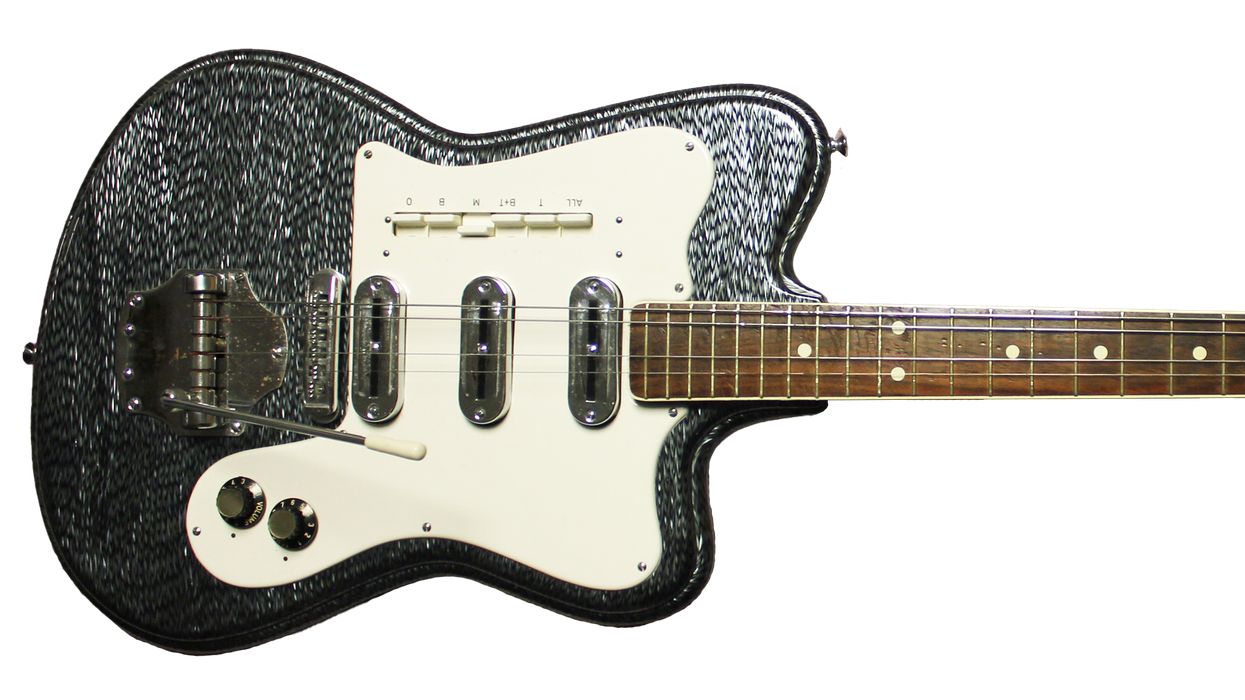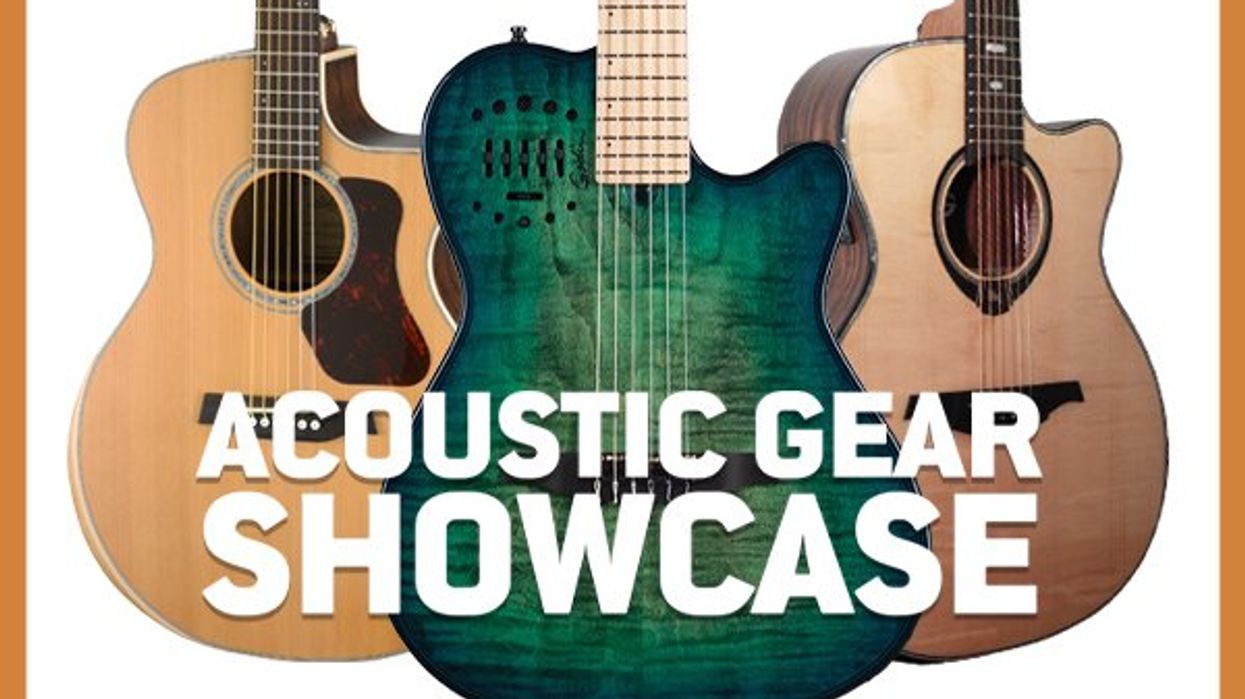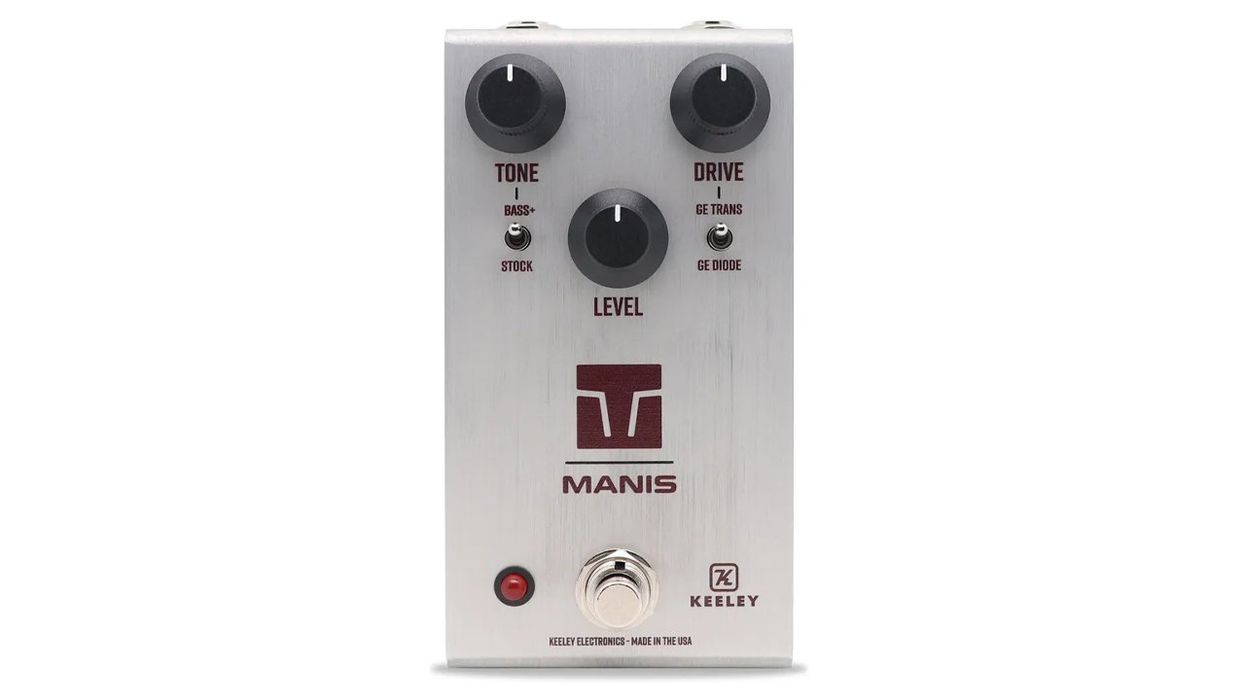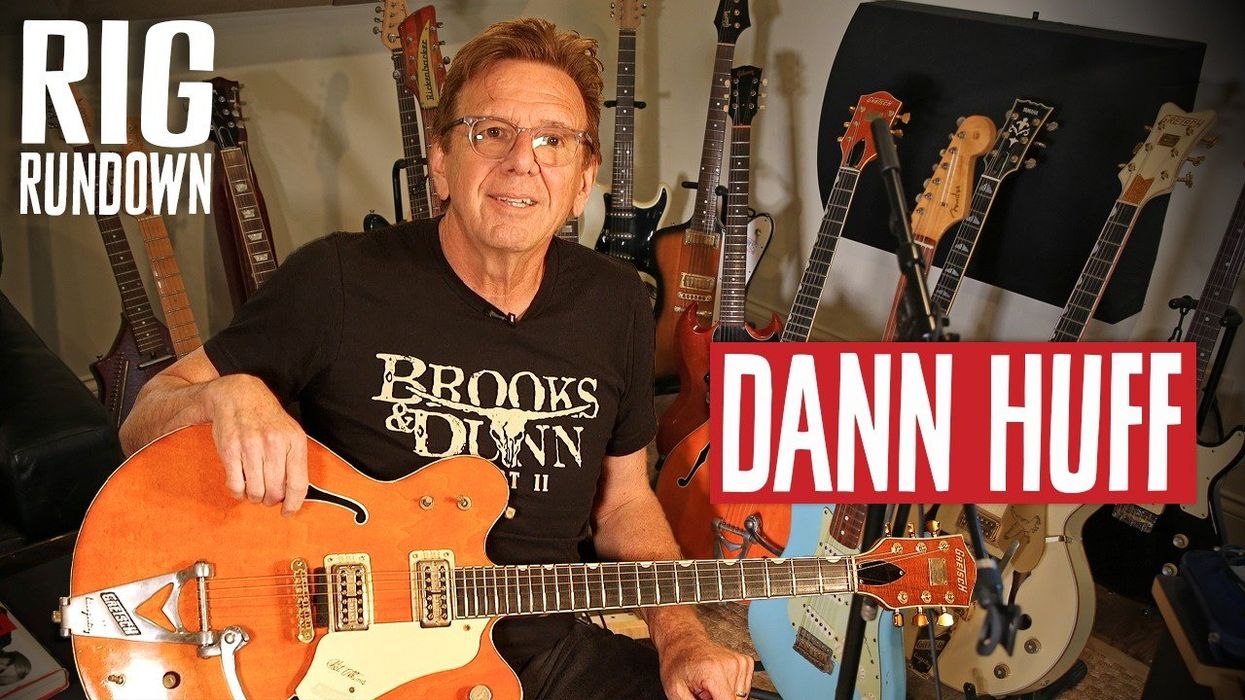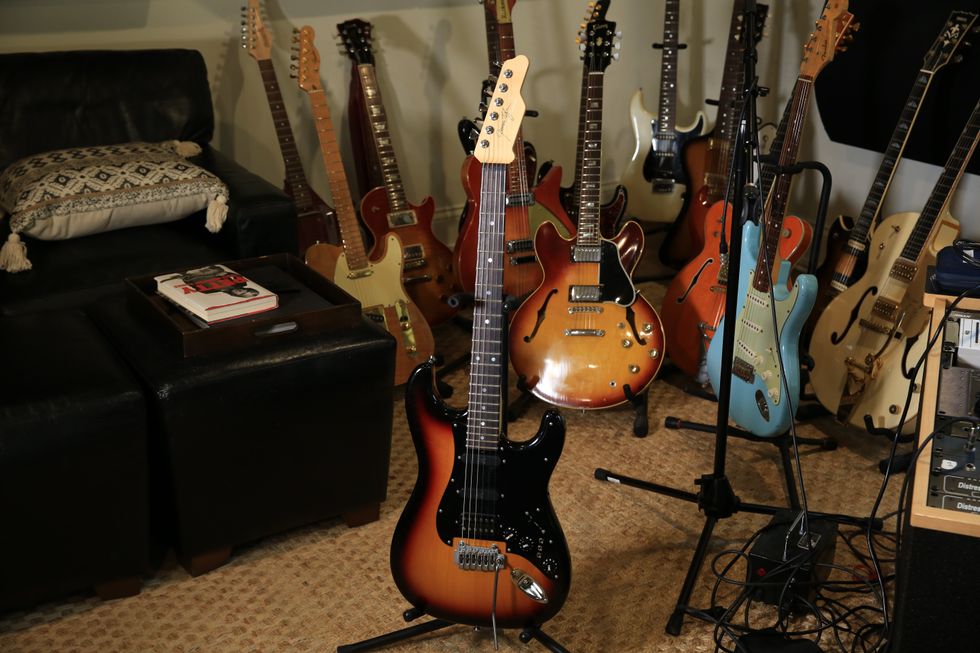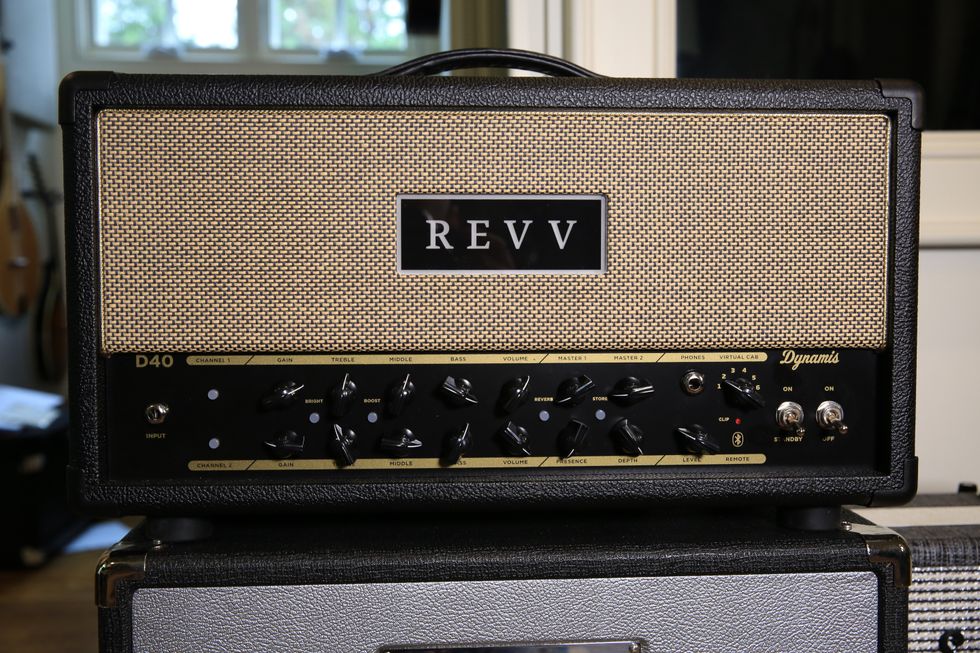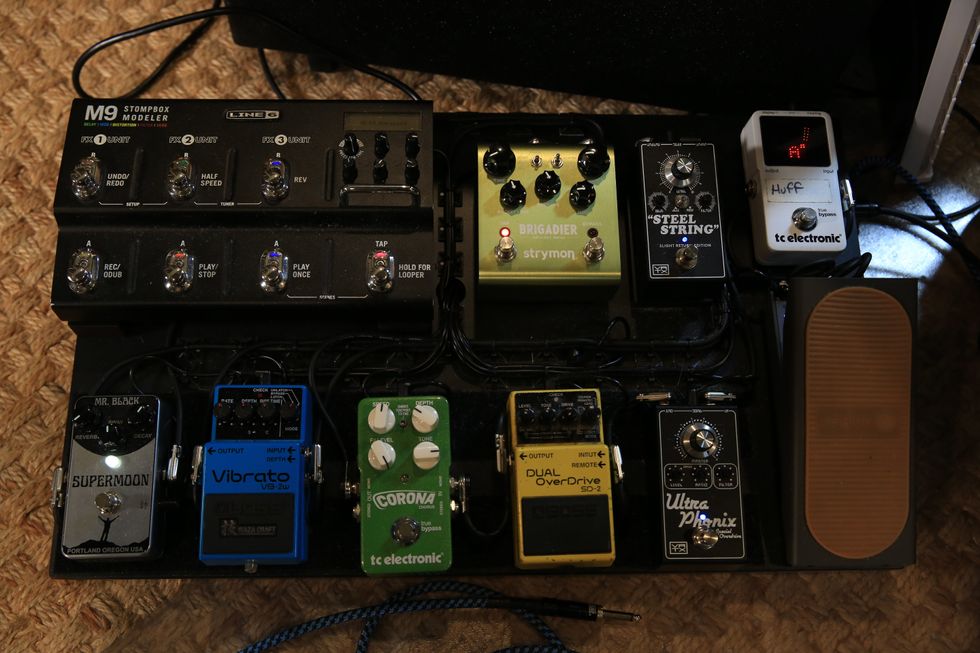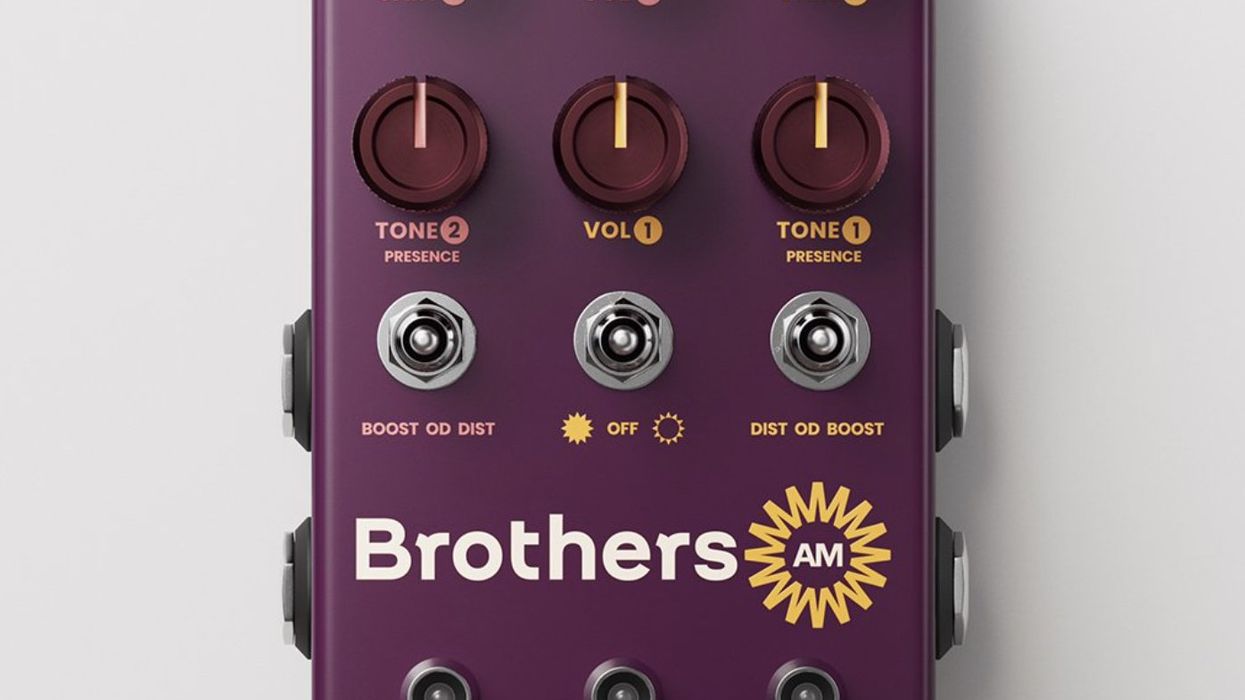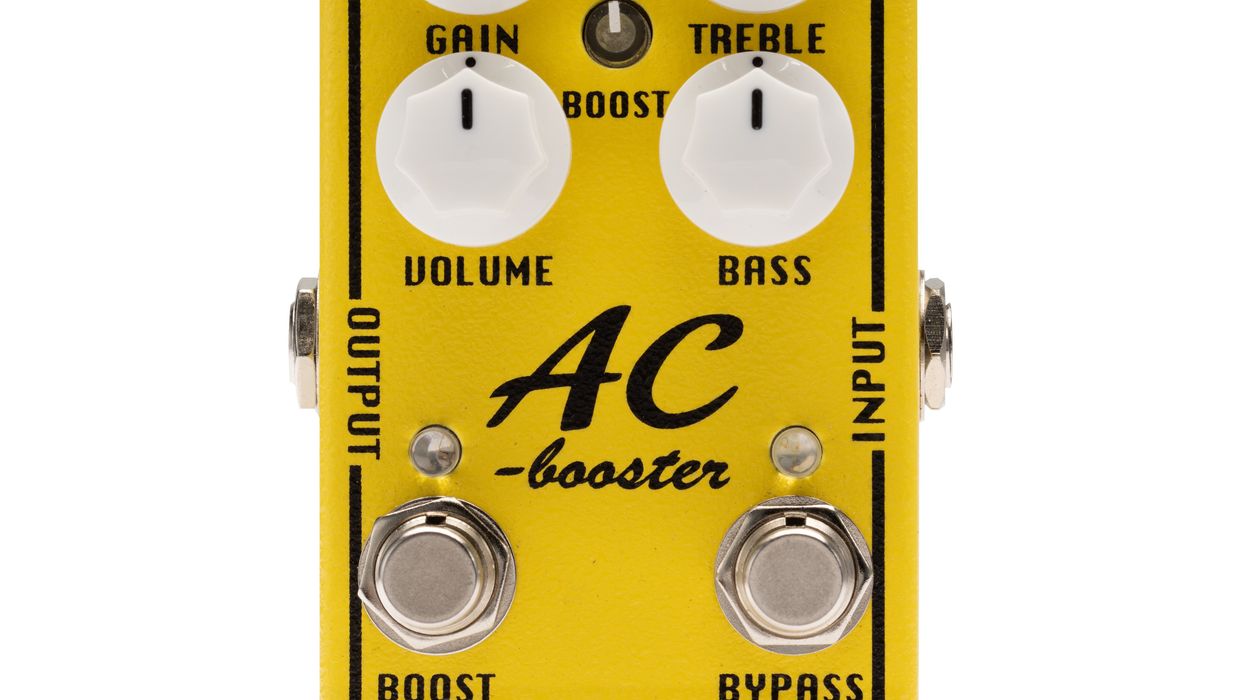At first blush, Sune Rose Wagner can seem like a man of baffling contradictions. Almost everything he’s done over the last 13 years, seven LPs, and five EPs as guitarist, songwriter, co-vocalist, lyricist, and multi-instrumentalist for Danish garage-surf duo the Raveonettes is antithetical to how the average guitarist would do it. A couple of perfunctory examples: He and fellow Raveonette Sharin Foo (vocals, bass, guitar) tend to steep their tunes and guitars in so much fuzz and reverb—including two or three Boss RV-5 pedals at the beginning of the signal chain—that sometimes you can’t quite tell what instrument is making what sound. And then there’s the fact that both are avid fans of ’60s Jazzmasters, Musicmasters, and Mosrites, yet they’re thoroughly uninterested in amps of the era. Or any other, for that matter—they haven’t used a guitar or bass amp on a single Raveonettes track. Ever.
But the more you learn about how Wagner does things, the more you realize that maybe he’s not contradictory as much as he’s just a sonic sadomasochist in the name of art—someone who sees light in darkness, melody in cacophony, congruence in disparity, renewal in destruction. Someone who gets off on being confined and restricted.
Admittedly, the 41-year-old Sønderborg, Denmark, native’s approach also has a lot to do with being as big a devotee of the Everly Brothers, Buddy Holly, ’60s girl bands like the Ronettes, and Phil Spector’s “wall of sound” production style as he is of the Cramps, the Jesus and Mary Chain, and ’80s hip-hop pioneers like Eric B. & Rakim. But with sweetly morose lines like “Flowers in the daytime and Lucifer at night” (“Observations” from 2012’s Observator) being commonplace in the Raveonettes repertoire, there’s got to be more going on in Wagner’s mind than a hodgepodge of musical influences.
How else do you explain a guy who says drums are his favorite instrument to play (he picked them up at age 5), yet insists on using loops rather than live drums on all his albums? Not to mention, on every Raveonettes release—from their 2002 debut, Whip It On, on up to this summer’s Pe’ahi—it seems the more constraints Wagner puts on himself, the more he’s inspired.
For Whip It On—where the Raveonettes’ now-signature ambience envelopes huge dance-club beats driving fuzzed-out spaghetti-western riffs that sound like someone slipped Chet Atkins LSD and a cranked RAT pedal—Wagner willingly strapped himself into the dungeon-master garb of playing every tune in Bb minor. For the follow-up, 2003’s Chain Gang of Love, it was nothing but Bb major. And for this year’s LP named after the famous Maui surfing spot, the longtime L.A. resident decided to challenge himself both physically and mentally: He switched to gargantuan flatwound strings—.014–.055 sets—and based his writing sessions on a willfully obtuse set of diametrically opposed lyrical themes.
“If you commit to a certain … not necessarily a theme, but a way of thinking—a certain inspiration—it makes it worthwhile. It’s a lot easier,” Wagner explains. “It’s the contrast in music that makes it interesting. If you can take a song and lure people in with a great guitar line, or a great melody, or a fantastic beat, all of a sudden they realize that they’re in a very different universe. This is not just a happy song, this is about something else. It doesn’t have to sound evil to be evil.”
We recently spoke to Wagner about his creative process, his recently revamped pedalboard, how he sounds nothing like his early 6-string heroes (including Mark Knopfler, Jimmy Page, and Randy Rhoads), and how the surf and skate culture and Pearl Harbor inspired the lush, addictively gripping tunes on Pe’ahi.
You often choose themes or strict parameters to work within when you’re writing for a new album—like the key restrictions for Whip It On and Chain Gang of Love. This time around, the album title and songs like “Endless Sleeper,” “Z-Boys,” and “Kill!” reflect another set of thematic restrictions. Does confining yourself that way make you more productive as a songwriter?
Yeah, I think it’s great. I know this is a strange analogy, but I have always been fascinated with fashion designers. They have to make at least four collections a year: spring, summer, fall, and winter. They’re inspired by what’s coming up next, what the colors are, what people are into, and all that stuff. I think it’s the same when you make music. If you commit to a certain … not necessarily a theme, but a way of thinking, a certain inspiration, it makes it worthwhile. It’s a lot easier.
For a lot of musicians, powerful, unexpected events tend to inspire new songs—you hear a touching news story, have a really cool experience out in nature, or whatever. But a theme is kind of the opposite. What kind of headspace do you have to get into to really feel inspired by your theme? Is there a trick to getting inside your theme and having it work for you instead of against you?
Yeah, I can use the new album as an example. The inspiration with this album was war. It was southern California surf culture and the prettiness and beauty of Polynesia, especially Hawaii. If you take those things and put them together, you quickly realize that there’s something wrong. Why would you take something innovative, exhilarating, and exciting, like surfing and skateboarding history, and add it to something really beautiful like Hawaii or some exotic island, and then add a different theme about war—something that’s destructive and ugly and despicable? You see pictures from the attack on Pearl Harbor, and what you see in the foreground is beautiful palm trees, a tropical island—sort of heaven on earth—and then in the background you see the USS Arizona on fire, people dying and screaming, Japanese bombers unloading their evil bombs on this pretty island. When you look at it, it doesn’t make any sense—because how could you have so much beauty and destruction at the same time? It doesn’t make sense.
It’s sort of like Bikini Atoll, the atomic-bomb test site: If you see that famous picture, in the foreground there’s a beautiful, tranquil, serene beach with palm trees, little huts, and a really beautiful ocean. Then, in the background, there’s a mushroom cloud. It doesn’t make any sense! But as long as humans have lived, it actually does make sense. That’s why we have black and white. It’s why we have night and day. It’s why we have beauty and the beast. That’s why we have happiness and sadness. To me, there’s nothing weird about it. I just like to find things that people maybe don’t think about that much.
How would you say the Raveonettes sound—both the band’s overall vibe and your guitar approach—has evolved over the years?
The guitar approach has pretty much always been the same. We never used any amplifiers in the studio. We were strictly into recording into the computer and not using amp simulators or anything like that. We’d basically just go through our pedalboard and then into whatever mic pre we had available at the time. The only thing that’s really changed in that sense is that sometimes we would have a Neve preamp, sometimes we would have a Shadow Hills preamp, sometimes something else. It depends on where we are, I guess.
The first three albums had more of a punk/indie feel mixed in with the surf vibe, and then starting with 2008’s Lust Lust Lust, it’s increasingly become more of this dichotomy of haunting, addictively sweet melodies and chaotic ambience. What inspired that—was it organic or something you consciously moved toward?
I think it’s just what you’re into at that point. We try as much as possible not to repeat ourselves too much. We understand that we have a certain sound, and people can always hear that it’s a Raveonettes song. But to do two of the same albums in a row is not really interesting to us. We always try to mix it up a little bit. The last album we did, Observator, wasn’t really a noisy album. It was more of a nighttime-driving, dreamy, flowing, very depressing kind of album. This time we wanted to do something that was more in your face—more like a big rock album, but that still had some unusual song structures with great parts.
What got you into the whole approach of going direct with your pedalboards?
It was just a sound that I liked—I really enjoyed the sound of it. It was different from other stuff that I heard. I love old sounds and what you can do with amplifiers and stuff, but I never really thought it fit our music very well. We tried many times to record through amplifiers, but we would always just go back and plug it straight in. That’s the Raveonettes sound.
So the allure was mainly that you felt it enabled you to achieve a more distinctive tone?
Yeah. Guitar pedals work very differently when you do that compared to plugging them into an amp. There are certain harmonics and overtones you get that you wouldn’t get through a guitar amplifier. A guitar amplifier is much more sophisticated. That’s why it’s always been really hard for us to find guitar pedals. You go to a guitar store, and you can try out a bunch of pedals through an amp and they sound amazing. Then when you go home and try them out without an amp, they sound completely different. Some of them sound better than you expected, but some of them sound worse and then you have to drive back and return them. It’s always a gamble.
Sune Rose Wagner's Gear
Guitars
1963 Fender Jazzmaster
1960s Mosrite Ventures II
1959 Fender Musicmaster
Effects
Vintage Pro Co RAT
Two Boss RV-5 Digital Reverbs
Catalinbread Echorec
WMD Geiger Counter
ZVEX Vexter Series Box of Metal
EarthQuaker Devices Bit Commander
MXR Custom Shop La Machine
Recording Gear
Pro Tools
Neve 1073 preamp
Shadows Hill preamp
Crane Song Falcon compressor
Waves S1 Stereo Imager plug-in
Soundtoys EchoBoy plug-in
Strings and Picks
.014–.055 sets
.010–.046 sets
Do the ones you end up buying offer more sonic possibilities through the direct recording method than if you used them through an amp, or is it just different?
It’s just different. You can’t compare the sounds. One of them is a really nice, round, tube kind of thing, and the other is very digital—static almost. It’s a very unusual sound, especially when you have reverb pedals and stuff. The harmonics and overtones react with the reverb very differently than if you had just plugged it into an amp. It’s not really a pretty sound, but it works for what we need it for. Also, the way we route the pedals is different: We basically go from a guitar straight into all the reverb pedals, then we have the distortion at the end. Before we even hit the distortion pedal, the signal has gone through two or three other types of pedals. That messes up the harmonic spectrum of whatever distortion unit we’re using.
It must make the whole process less predictable, too.
Yeah, exactly. You never really know what you’re going to get. That’s also why we don’t do demo recordings—we commit to what is there. We’re basically just recording the album as we write the songs. Most of the time it’s just impossible for us to create a sound again. If we have a song and really like it, maybe I’ll say, “Oh, we should add another section to the song,” but if we do, it has to be a very different kind of section, because there’s no way that I can recreate the guitar sound—even if I took a picture of the pedals. It just won’t be the same. We have to loop or copy and paste a lot of guitars to make the sound fit at the end of the song compared to the first part of the song. There’s a lot of work with it, but in a fun kind of way.
So you always track guitars with the pedals engaged from the outset?
Yeah, we commit to the sound immediately. If you like that sound, you have to commit to it. You can’t recreate it. That’s the sound, and that’s it.
Sune Rose Wagner's pedalboard.
Do you use plug-ins on the guitar tracks, too?
I always EQ the guitar, yeah. There are some pretty harsh overtones that you need to get rid of. Maybe I’ll compress it a little bit. Again, it depends on what it’s needed for. Usually the only plug-ins I use on guitar are ones that help the guitar spread out. If I want a little bit more stereo widening, then maybe I’ll use, like, a Waves S1 Stereo Imager, or maybe go through a Soundtoys EchoBoy plug-in with very minimal settings, just to give a bit of wideness to the guitar. Very rarely … well, lately I’ve been using it a little bit more, because sometimes it’s nice to have a big stereo-reverb sound, kind of like a Chris Isaak vibe. I’ll go through a reverb to make a nice, big sound—sort of like what you hear in “Z-Boys,” that clean guitar with a nice, big stereo sound. But I don’t record my guitar in stereo—it’s all mono. So if I want to do something stereo, then I’ll put a stereo plug-in on.
In the past, you guys have used Fender amps when you play live, right?
Yeah. We used to have Fender amps with us live, mostly because we wanted something onstage that we could listen to that wasn’t just a harsh, monitor kind of sound. This was before we played with in-ear monitors.
But you were also sending a direct signal to the front-of-house board?
Yeah. That’s all he gets—he doesn’t use the amp sound live. All you hear live is the direct signal, like on the album.
A month or so before Pe’ahi came out, you posted a picture of your pedals on Facebook and said the EarthQuaker Devices Bit Commander, WMD Geiger Counter, ZVEX Box of Metal, and Catalinbread Echorec were “essential” to the new album.
Yeah, 100 percent.
Which ones did you use the most—or did you often use them simultaneously?
Oh, I always try to experiment with each song and see what it needs. But on each song there’s a lot of guitars—anywhere from 10 to 30 guitar tracks, and they all basically have a different sound. There might be five tracks of Geiger Counter and five tracks of Box of Metal. Obviously there’s also the RAT—which has been my go-to pedal for over 20 years. It really depends on what sounds good together. It’s basically just trial and error.
What’s your favorite preamp to use with your pedals when you’re recording direct?
What I’ve been using for a long time is a Neve—the 1073—which then goes into an API 550 EQ. That goes out to a Falcon—a really great tube compressor that Crane Song did. It takes a little bit of the harshness off.
And that’s the entire signal path, post-pedalboard?
Yes.
YouTube It
Do you record into Pro Tools or Logic or…?
I use Logic and Pro Tools, but for this album I opted to use Pro Tools. There’s really no rhyme or reason for that. I just started a couple of sessions really got rolling, so it was like, “Oh, I’ll just stick to Pro Tools.”
What guitars did you use for this album?
My ’63 Fender Jazzmaster and my 1959 Musicmaster. I also have a Mosrite Ventures II. I don’t know the exact year for that, but I had it appraised once and he was pretty sure that it was mid ’60s.
Are they pretty much stock?
They’re all original.
Do you use multiple guitars on each song, or do you tend to stick with one for all the different layers?
Again, it depends. I will say that the Jazzmaster is what I always start with, and then I sort of work my way up and try to experiment with some of the other sounds. If there’s a guitar theme, maybe I’ll try it on some of the other guitars to see what it sounds like.
Do you look for a different sound from the Mosrite and Musicmaster, or is it more for a change of scenery?
It’s a change of scenery. Sometimes if you sit there for hours with a Jazzmaster and take a break for food, when you come back and look at the Mosrite you think, “Fuck, I love that guitar—I want to play that now!” Also, on the Musicmaster and the Jazzmaster, I have very heavy-gauge strings.
What gauge?
They’re .014 to .055, flatwound.
In standard tuning? Yeah, but we always tune down one half-step, so we’re always in Eb.
Sune Rose Wagner's 1963 Fender Jazzmaster.
What made you decide to switch to such heavy strings?
I like the sound of it. That was really the only reason. I experiment a little bit. I do a lot of music that’s not just for the Raveonettes. I’m always writing songs. I’d done this song that was really pretty, like a lullaby kind of song. I put really heavy guitar strings on for it, and I just loved the sound. I figured I should just keep them on and do the new Raveonettes album that way. I decided to put heavy strings on the Musicmaster as well, and I keep the Mosrite with regular strings—.010 to .046 roundwounds.
So this is a relatively recent development for you?
Yeah, I’ve never tried it before.
What specifically do you like about the heavier strings—is it because it sounds more robust?
Yeah, I think so. You can’t really bend the strings that much, so there’s not a lot of noodling you can do. You have to figure out how to make everything sound pretty interesting using things like arpeggios or other ways of playing. It’s a challenge to come up with something. I kind of like that. You think about playing a little bit differently, which is always a good challenge.
You guys have been huge fans of Boss reverb pedals for a long time. You’ve got two at the beginning of your pedalboard, right?
Yeah. We don’t use the RV-2s anymore, because they’re old, they break, and they don’t have spring reverb [simulations]. When the RV-5 came out, we immediately changed over to those. I have two of them on my board, and Sharin has three.
Would you go as far as saying RV-5s are crucial to the Raveonettes sound?
Oh, they’re 100 percent crucial. I don’t think I could play a show without them. It’s the best-sounding spring reverb I’ve ever heard. Nothing compares to it. I don’t know how they did it, but it’s absolutely amazing. I haven’t heard a plug-in, an amplifier, or anything that sounds as good as that spring reverb. I have no idea how they were able to get such an amazing sound. It’s pretty crazy.
Do you ever use them to process vocals or drums in order to have a cohesive feel in the ambience?
No, not really. We have in the past a little bit while re-amping stuff, but mostly we don’t. There are other signal processors that I prefer, like an old Yamaha SPX90 or a Lexicon PCM-60. Those two we use all the time. All the reverb sounds you hear on Lust Lust Lust are the SPX90, all the drum sounds.
Wow—you’re still using those?
Every single day. It’s all over the new album, as well. That’s my number-one, go-to signal processor, the SPX90.
Those were all the rage back in the ’80s.
Yeah, you can get one on eBay for 90 dollars!
You expanded the sound palette in a number of ways on the new album. You’ve got the massive hip-hop beats, harp parts, a choir, the fuzz is more extreme than ever—sometimes it’s borderline industrial—and you’ve gotten into bit-crushed sounds. Yet it’s still gorgeous and haunted like classic Raveonettes. When you find yourself itching to expand your sonic palette like that, is it difficult to make it feel consistent with your sound, or does it all just happen pretty naturally?
It happens pretty naturally. I don’t think about it. It’s not something that we discuss or anything. We just do it. I knew I wanted to make a little bit more brutal sound. That’s why I went out and got all these pedals like the Geiger Counter, Bit Commander, and all that—to see if I could find some kind of combination with guitars that I could achieve that sound with. God knows what’s going to happen on the next album—we’re probably going to take all the pedals away and just have an acoustic guitar or something. You never know! That’s the beauty of it. I’m already looking forward to making a new album, because I can’t wait to see where it’s going to go.
Speaking of a more forceful guitar sound, “Sisters” has one of your craziest solos ever. What was going through your mind there?
I was trying to achieve something that was … I guess melodic, in sort of a strange way. It’s not like a super melodic solo—it doesn’t have any tones that aren’t within the pentatonic scale until halfway through the solo, where I broke a guitar string. That solo was played on the Mosrite. I broke my high E string, and things went completely out of tune, so that’s why the last half of the solo sounds very frantic and kind of neurotic. To me, that was just beautiful. It was a one-take solo, and I achieved exactly what I wanted to achieve.
Let’s talk about your guitar influences. You’ve said in the past that, growing up, you were into players like Mark Knopfler, Robert Johnson, Hendrix, Page, even Randy Rhoads—players no one would’ve guessed based on your playing. Did you consciously move away from a guitar-centric mentality, or did those influences just organically blend together with other bands you got into?
I think I just became more interested in songwriting. I used to just be a guitar player until I was 19 or 20 years old. I was strictly just a guitar player. Actually, I was a drummer since the age of 5, so drums were really my main instrument—and actually the instrument I enjoy playing the most. But it wasn’t really until I became more of a songwriter and a singer that I thought I’d much rather have a really nice bridge or something instead of just throwing in a solo. If I did have to throw in a solo, sometimes I could make it crazy, but other times I could make it super melodic. There are a lot of really beautiful solos on the Lust Lust Lust album. Very slow, melodic solos. Most of that stuff is sort of my Mark Knopfler influence—the way he’d repeat a certain motif or pattern over chord changes. I learned a lot from these guys when I was a kid. I started to use it in my own way, I guess.
Sune Rose Wagner's mid-'60s Ventures Mosrite.
You say drums are your favorite instrument, yet you guys don’t use real drums in the studio—only on tour. Why?
I’m not a fan of real drum sounds. It all sounds the same to me. I love using samples—they’re so diverse and interesting. I love mixing various drum sounds together … maybe have three or four different kicks and four or five different snares. I love drums but I want them to sound interesting and special.
When you’re writing a song, which parts typically come to you first—vocal melodies, guitar melodies, chord progressions, lyrics?
Lyrics always come last. I usually start off with a melody line of some sort, because I write mostly on piano. I find it to be an easier way to write, because it’s a very melodic instrument—you can have chords and melody play at the same time. To me, that’s just a no-brainer. Sometimes, you have to come up with certain guitar things or things that sound a little bit more guitar driven. Most of them are written sitting in front of the TV, watching whatever with a guitar in my hand. Something comes up, and I just record it really quick on my iPhone to look at later. Mostly, I write melodies and certain motifs and themes on the piano.
For many songwriters and guitarists, the way bandmates react to riffs and progressions often helps them evolve in fresh new ways. Is it difficult to come up with these rich tapestries of sound when it’s just you and Sharin doing everything?
Yeah. Essentially, it’s just me, because Sharin doesn’t write. I knew on this album that I couldn’t complete it myself. I needed help, because I had so many ideas—I was so inspired. The ideas were all over the place, and I needed someone to sit down with me and dig out the good stuff and make some crazy arrangements. That’s why I asked Justin Meldal-Johnsen [Beck, Nine Inch Nails] to help me and Sharin produce. There’s no way this album would have sounded as good without him. He was invaluable, for sure.
So he was sort of a sounding board for song ideas and arrangements?
Yeah, everything. Like a sparring partner. Whenever I was in doubt or had questions, I’d call him up or shoot him an mp3, or he’d come to my place. We would sit down and talk, sometimes for four or five hours. We’d just talk about music and listen to little snippets of ideas. It was done very musically, very hands-on in talking about certain chord progressions or the way to play certain chords or whatever. But at the same time, we also talked very abstractly about things like feelings and what you get out of playing a certain way as compared to playing it another way. It was an amazing experience. I absolutely loved it.
What’s an example of one of those situations where he suggested you try playing things in a different way?
For instance, on “Wake Me Up” I wrote a little string motif and said, “You know, it’d be nice if you could expand on it.” He’d be, like, “Yeah, but the way the song is now, it doesn’t really translate.” Then I’d write a new chorus, and the idea would be to write some weird, disharmonic chords and stuff. I did, and he liked it, and immediately we could hear what we needed next. Then we needed to get a string arranger. He knew this guy who was a film composer, so we got him involved and it tied the whole thing together. There’s no way I would have ever finished that song without him. It was just one of those songs where I had no idea what to do. I was completely stuck.
Before we wrap things up here, let’s get a little abstract. If you were interviewing yourself for a guitar website, what would you ask?
I would say, “You have a very unique style, and you have influenced so many bands and people. Everybody’s into surf music and girl groups all of a sudden. Why is it that you are never mentioned among all the great guitar players or all the guitar bands that are out—all the Jack Whites or whatever?”
What would your answer be?
It would be, “I have absolutely no idea why—Jesus Christ!” I play a mean blues, as well. Trust me, I can play exactly like Mark Knopfler but nobody knows it [laughs]. I can even play the same fingerstyle things that he does with three fingers!
If you could ask one of your guitar heroes—living or dead—a single question, who would it be and what would you ask?
I wouldn’t ask anything, I would just say, “You know Mark—Mr. Knopfler—that song “King’s Call” that you did with [Thin Lizzy singer and bassist] Phil Lynott? It’s fantastic—such an amazing solo!” I’d basically just congratulate him on that, I think.
Okay, last question. Close your eyes, take a deep breath, relax, and—as lucidly as you can—envision yourself playing guitar onstage or in the studio. Think about the minutest details of how you approach your instrument. Put it under a microscope. Now, what’s the single most important part of how you approach your instrument—what is it that defines your sound?
It’s emotion. It really is—I need the music to dictate to me where I want to go with whatever guitar I’m playing. It’s strictly just based on emotion.
Yeah, yeah. In a way, my sound is pretty simple. Most of the time it’s really just a digital reverb and the RAT pedal. I can pretty much do any song with just that setup. If I always have that at hand, I’m ready for whatever the music needs me to do.


